
Unique Cherenkov telescopes in the Czech Republic observe the Crab Nebula
13. 05. 2022
The first and unique installation of high-energy gamma-ray imaging Cherenkov telescopes in the Czech Republic has been successfully completed at the observatory in Ondřejov. Both telescopes have thus become the largest optical telescopes in the country and their quality is comparable to the instruments that will operate at the Cherenkov Telescope Array (CTA), the most sensitive international high-energy gamma-ray observatory in the world.
Observations of the night sky have begun with the aim to detect the first sources, focusing mainly on the historic supernova from 1054, known as the Crab Nebula. Observations are being made with both telescopes simultaneously, allowing the Academy of Sciences scientists to more accurately reconstruct the trajectory of the observed showers initiated by high-energy gamma photons. The combination of the telescopes' images gives them a three-dimensional view of the shower of secondary particles, which allows them to determine the direction of arrival of the original gamma photon very precisely.
"The telescope's observing program will contribute to understanding a range of fundamental questions about the Universe. Our main goal is to understand the functioning of cosmic photon sources with energies of about 1 teraelectronvolt, 1012 eV, which is about a trillion times more than the photons of visible light," says Petr Trávníček, the head of the SST-1M science team from the Institute of Physics of the CAS.
As part of international projects, the SST-1M consortium plans to relocate the instrument to another observing site at a higher altitude once it has been tested. "The SST-1M consortium was born from the idea of using a telescope with a 4-meter primary mirror and an already proven optical configuration, known as the Davies-Cotton telescope, to observe gamma photon sources. Our innovation efforts in this regard have focused on improving the camera - at the University of Geneva, we have the best expertise in project management, system engineering, photosensors, or telescope control and data analysis," said Professor Teresa Montaruli of the University of Geneva, the leader of the international SST-1M collaboration, about her institution's involvement in the project.
The commissioning of the SST-1M telescopes in Ondřejov would not have been possible without the involvement of Polish scientists. It is thanks to them that the mechanics of the telescope and the digital electronics of the camera were successfully solved. "The H. Niewodniczański Institute of Nuclear Physics in Poland has extensive experience in the field of motorized control and operation of the telescope as well as in the design of the mechanical structure. And the University of Krakow has developed digital camera electronics," says Professor Jacek Niemiec of the Polish Academy of Sciences.
The optics of both telescopes, including the production of high-quality reflective layers and the precise alignment of the mirror segments, are the responsibility of scientists and technicians from the Institute of Physics of the CAS and Palacký University, who also collaborated with experts from the Astronomical Institute of the CAS in the preparation of the observing site in Ondřejov and the commissioning of the telescopes.
More about the telescopes:
In the preparation of the SST-1M Cherenkov telescopes, the following institutions participated: the Institute of Physics and the Astronomical Institute of the CAS, Palacký University in Olomouc, the Henryk Niewodniczański Institute of Nuclear Physics of the Polish Academy of Sciences, the University of Geneva and other institutions of the SST-1M consortium.
The first telescope has been in observation mode since 23 February 2022, when it recorded the so-called first light. The second telescope recorded the first cosmic ray shower events on 19 April, during a combined observation with the first telescope (both were focused on the same source in the sky).
Cherenkov telescopes; source Astronomical Institute of the CAS
Read also
- High-energy cosmic rays dominated by heavy METALS
- Genome Tool Developed at CAS Featured in PLoS Genetics
- Why do brain cancer cells steal mitochondria?
- Secrets of the Nano- World: a new comic book about nanotechnology
- Teen duo from Slovakia and Czechia named Global Winner for clean water solution
- Professor Pavel Hozák Receives the Paul Nakane Prize
- Neutrino is lighter than previously thought
- The Earth Prize 2025 goes to Czechia and Slovakia for pioneering water purifier
- Scientists discover compound that “should not exist”
- Horizontal mitochondrial transfer is a key process in tumor biology
The Czech Academy of Sciences (the CAS)
The mission of the CAS
The primary mission of the CAS is to conduct research in a broad spectrum of natural, technical and social sciences as well as humanities. This research aims to advance progress of scientific knowledge at the international level, considering, however, the specific needs of the Czech society and the national culture.
President of the CAS
Prof. Eva Zažímalová has started her second term of office in May 2021. She is a respected scientist, and a Professor of Plant Anatomy and Physiology.
She is also a part of GCSA of the EU.